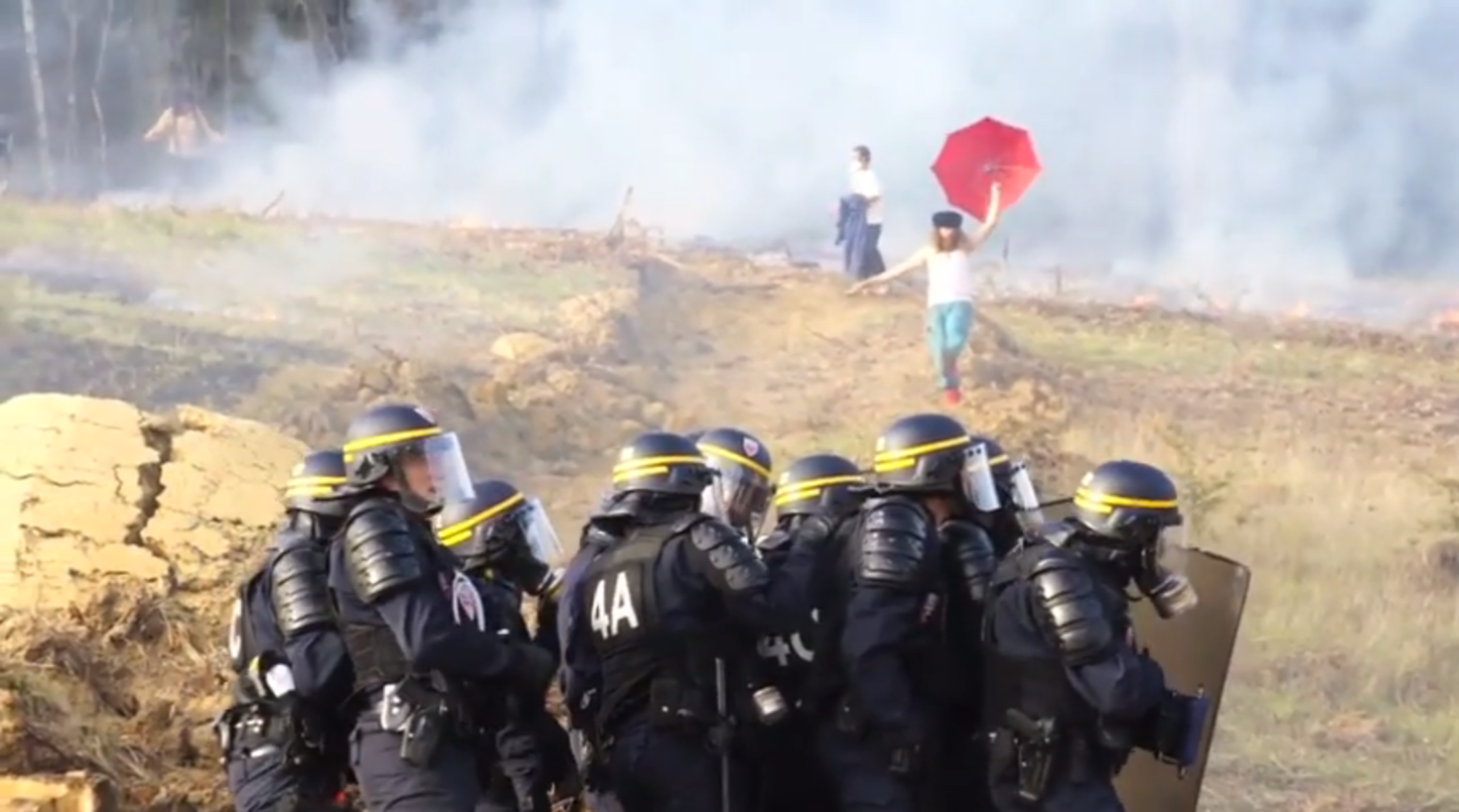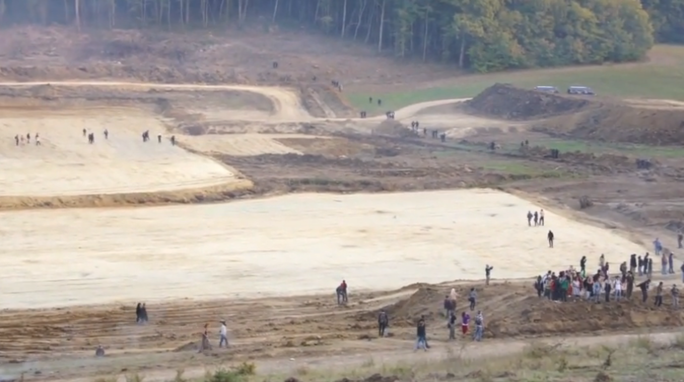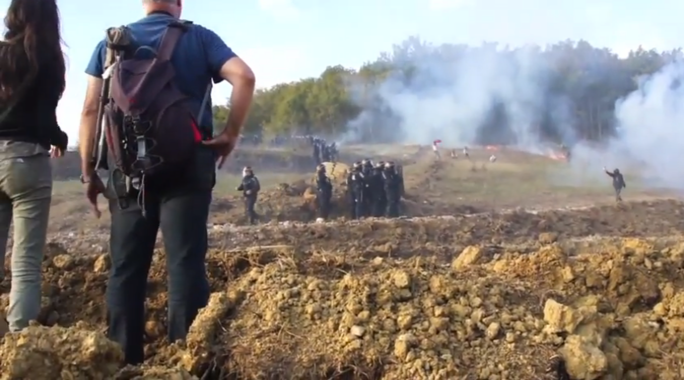The death of protester Rémi Fraisse last weekend during demonstrations against a controversial dam project in south-west France caught the French government off guard and sent shock waves through the political establishment. Botany student Fraisse, aged 21, described by friends as a “gentle” and non-violent person, was found dead in the early hours of Sunday October 26th, after clashes between demonstrators and gendarmes over the building of the Sivens dam at Testet in the Tarn département or county in south-west France. A formal investigation by independent examining magistrates is now under way but the evidence so far points to him being killed by a so-called 'offensive' grenade thrown by one of the gendarmes policing the site. Protesters have been occupying the area to prevent the building of a 304-metre dam across the valley that will create a 2 kilometre long reservoir to be used by farmers to irrigate their crops. Opponents say the project, overseen by the Tarn council, is unnecessary and will destroy an important area of wetland.

Enlargement : Illustration 1

Politicians from the green EELV party and other environmentalists say they had warned about the potential for a tragedy to occur at Testet given the strong presence and “violence” of the gendarmes there in recent weeks. Former minister Cécile Duflot, who visited the site a week before Rémi Fraisse's death, says she was “very surprised” by the “gendarmes' methods” which she found “very violent and provocative” and warned both the local prefect and others in authority when she returned to Paris. Calling for a commission of inquiry into the circumstances surrounding the death, Duflot spoke of “an absolutely intolerable situation which will end up being...an indelible stain on the government’s actions”. Arié Alimi, the lawyer acting on behalf of the young victim's family, who has filed a complaint for murder, meanwhile said: “We have here an unprecedented state scandal. Several warnings were given, they were not heeded.”
It was not until Tuesday morning, however, a full two days after the tragedy, that the highest echelons of the government responded to the events. President François Hollande revealed he had spoken to Rémi Fraisse's family and talked of the need for “compassion”. He then called for the “full truth” of events to come out before urging “responsibility” from people in their public declarations – comments widely seen as a rebuke to Duflot and her fellow greens, who until March 2014 formed part of the government.
Prime minister Manuel Valls, who was the interior minister until March 2014, took an even tougher line. After urging “dignity” in people's behaviour and “transparency” in the investigations into the death, he attacked those he said had jumped to conclusions about what had happened. “The forces of law and order perform extremely difficult work, often faced with extreme violence,” the prime minister told MPs in the National Assembly on Tuesday. “I won't accept the gendarmes, many of whom were injured, facing accusations before an investigation has even been concluded.”
Valls was also forced to defend his interior minister Bernard Cazeneuve against calls that he should resign, saying that the minister was the victim of “hasty declarations”. Cazeneuve himself said his first thoughts were with the “family and friends of Rémi Fraisse” after the “tragedy”, but he also attacked the “unacceptable violence” used by protesters at the site since September and said that certain politicians were “manipulating” the situation for their own ends. Green MP Noël Mamère retorted: “In all other democracies when there is a death in a protest the interior minister resigns.”
Sources within and close to the government were dismayed by the slowness of the executive to react to the situation. “The reaction was extremely late, I don't understand it,” said one government adviser. “The government didn't see this coming, they didn't expect things to degenerate to this extent,” said a senior socialist MP. The government was also accused of failing to grasp the extent of local opposition to the dam, rather as it had not anticipated the bitter opposition to the plans for a new airport at Notre-Dame-des-Landes near Nantes in west France. “Martin Malvy wanted this dam,” shrugged one official who is a regular visitor to the Elysée, referring to the socialist president of the Midi-Pyrénées region where the project is based.
Even on Tuesday, as the magnitude of the tragedy began to dawn on the public authorities, the centrist MP for Tarn Philippe Folliot drew applause from several socialist MPs when he criticised the way an “active minority” was able to “block projects” such as the Sivens dam. Another senior socialist MP also sought to play down the drama, describing it to Mediapart as essentially a “local” issue. Privately some government ministers were deeply unsettled both by the death and the reaction to it. “It's an unacceptable tragedy,” said one. “I am obviously worried about the conclusions of the investigation. In any case, if fault is established it must be punished.”
'We felt it was going to happen'
By late Tuesday, as it became clear from the initial investigation that a gendarme's grenade was almost certainly the cause of Rémi Fraisse's death – traces of TNT from an offensive grenade were found on his clothes – the government did finally swing into action. Bernard Cazeneuve announced an investigation by the gendarmerie watchdog, the Inspection Générale de la Gendarmerie Nationale (IGGN), to “determine the conditions in which these projectiles are used in the context of operations designed to maintain law and order”. But at the same time he said he would not wait for the IGGN to reach its conclusions and he announced the “suspension” of the use of the so-called offensive grenades.
The offensive grenade OF F1 used by the French gendarmerie is thrown by hand and produces a large blast. It is used by officers to halt the advance of protesters or to defend a position. In normal operations these grenades can only be used with the authority of the prefect or their representative and after giving three warnings. But in cases where there is violence against officers or they feel they cannot defend their ground in any other way, there is no requirement for a warning.

Enlargement : Illustration 2

Such grenades, which have been in use for 50 years, are not designed to kill but even the ministry of the interior admits they can cause injuries. “There have already been injuries during violent demonstrations, with people's fingers mutilated when they have tried to throw them back, never any fatality,” says ministry spokesman Pierry-Henry Brandet. Mediapart has meanwhile spoken to a young protester, Elsa Moulin, 25, who nearly lost her hand after a sting grenade was thrown by a gendarme from the specialist unit the Peloton de Surveillance et d'Intervention de la Gendarmerie (PSIG) – which among other things handles riot control – was thrown into the caravan in which she had taken shelter at the Testet site on October 7th, 2014.
“He threw a grenade without seeing where it was landing,” said Elsa. “It fell a metre from me. I thought it was tear gas, I wanted to throw it out and it exploded – out of fear I didn't stop to think.” Another protester, Julie, 37, says she was not surprised by the death of Rémi Fraisse, as several demonstrators had already been injured. “We felt it was going to happen,” she told Mediapart.
Although the exact circumstances of the death are now being probed by examining magistrates, who are formally investigating “deliberate acts of violence” committed by a person acting on behalf of the public authorities that “unintentionally caused death”, the director general of the gendarmerie Denis Favier went on BFMTV to give his “total support” to the unit of officers involved. And he insisted that the person who threw the grenade would not be suspended from duty. “I think that there was no intentional, deliberate fault and thus I don't foresee anyone being suspended at this stage.” His officers, he said, had been harassed for hours and bombarded with stones, bolts and Molotov cocktails. “I am for transparency but I want us to be judged at the end of the investigation.”
In another attempt by the government to defuse the tension over the affair, environment minister Ségolène Royal announced on Wednesday that she had convened a meeting at her ministry on Tuesday November 4th of “all parties involved”, though it was not immediately clear whether this would include representatives of those who have been occupying the site. “We must find a solution that justifies the use of public and European funds for works like these,” she said. Royal also welcomed the “wise” decision of the Tarn council, the conseil général, who are in charge of the dam project, to suspend work indefinitely at the site.
However, the council’s socialist president, Thierry Carcenac, also made it clear in an interview in Le Monde on Wednesday that he does not want the project to be abandoned, though the council was set to deliberate on this on Friday October 31st. And the mood was not helped when Xavier Beulin, president of the main farming union FNSEA which has strongly backed the dam's construction, described some of those who opposed the dam as “green jihadists”. Beulin said there had been “disinformation” about the project which is“not a dam, but a reservoir, on farming land that is among the poorest in the Tarn, not to mention the Midi-Pyrénées”. The farming union leader also claimed that democracy itself was at stake. “When a decision is taken, you carry it out, otherwise it's not a democracy worthy of the name.” And he asked: “Does the government have any guts?”
In fact, Beulin's views about the need to carry out projects despite opposition chime in many respects with the comments of Manuel Valls both before and after the death of Rémi Fraisse. His implacable support for the forces of law and order and his opposition to the protests - “there is no place in our Republic, in a democracy, for rioters” he told MPs - stem from a double objective. The first is, above all, to avoid a repeat of the situation at Notre-Dame-des-Landes where all preparatory work on the proposed airport has stopped in the face of strong opposition and legal appeals.
'We've stood firm at Sivens'
Though the prime minister and senior officials will not admit it publicly, it is largely down to the occupation of that site that Nantes's proposed new airport has not yet been built. What was known in planning jargon as a ZAD - zone d'aménagement différé or 'future development zone' – became a different kind of ZAD for protesters: a zone à défendre or 'an area to defend'. Valls is determined not to find himself in the same situation as his predecessor Jean-Marc Ayrault, a passionate supporter of the new airport – he is an MP in the Nantes area – who saw the project blocked by the 'zadists'. Valls' fear seems to be that if the protesters are able to block the building of this dam in the Tarn, it could lead to protests stopping other, larger, infrastructure schemes in France, such as sports stadia at Bordeaux and Lyon, the rail tunnel linking Lyon to Turin in Italy and other railway projects.
But Valls' concern about the 'zadists' at the dam site is also linked to his attempts to form an alliance with large-scale farmers represented by the FNSEA, and also with the young farmers' body Jeunes Agriculteurs (JA). On September 6th, 2014, the prime minister addressed members of the JA at an open air gathering in south-west France that was the very antithesis of the kind of eco-farming advocated by agriculture minister Stéphane Le Foll. “I know the importance of better handling of water resources,” Valls told the young farmers. “It's a decisive factor for young farmers setting themselves up. That's why we have stood firm at Sivens. The work on this dam is at last going to start after the end of long consultation, and it's now a question of simply applying the law.”

Enlargement : Illustration 3

Two days later Ségolène Royal commissioned a report on the dam by two experts, published this week, which while it agreed that in the light of the work that had already been done the project should go ahead, severely criticised the scheme for being “overblown” and suggested several improvements. But by then preparatory works on the project had already begun. On September 14th zadists on the site noticed a renewed eagerness on the part of the developers to get on with the work and on that Sunday the security presence on the site was strengthened. The reason was simple; two days later, on Tuesday September 16th, an administrative court in Toulouse was due to give its verdict on a legal challenge by environment group Nature France Environnement who argued that the planned removal of the valley's trees was unlawful. At the time a young protester called Fabien, 25, told Mediapart: “They will do all they can to finish the removal of the trees before the hearing.”
He was not wrong. The police and gendarme units arrived that Sunday evening to allow the clearance machines to set up and start work at first light on Monday. By the time Tuesday's court verdict came in – the court ruled that Nature France Environnement did not have the legal standing to make the claim and rejected the challenge – it was academic; the trees had all been cleared some hours earlier.
The Sivens dam project is still the subject of legal challenges by opponents, notably the Collectif Testet, who are seeking to overturn the administrative ruling that the reservoir is 'in the public interest'. For them, the authorities' behaviour over the construction has come as no surprise as it closely mirrors the approach taken to a similar dam in the Tarn, the barrage de Fourogue, which came into service in 1998.
In both cases the Tarn council delegated the project to a semi-public company the CACG or Compagnie d’Aménagement des Coteaux de Gascogne. Its board is largely made up of departmental or regional councillors from either the Socialist Party or its allies the Parti Radical du Gauche, plus representatives from the local chambers of agriculture, all members of the FNSEA, and representatives from large banks. The CACG itself carried out the viability studies for the projects, based in part on figures from the chambers of agriculture.
In the case of the Fourogue dam, however, the needs and scale of the project appear to have been overestimated and the resulting income from farmers using the irrigation under-estimated. So while the break-even running costs of the project were put at 35,000 euros a year, the actual receipts are as low as 7,000 euros. Which means that in the fifteen years of operation so far the Fourogue dam has racked up a deficit of 420,000 euros; the bill was shared between the Tarn council and the CACG.
But that dam project's problems don't end there. In 2005 opponents of that scheme finally obtained a legal ruling quashing the declaration that it was 'in the public interest'. This has meant that, rather than handing control of the dam back to the council as planned, the CACG has continued to run the reservoir, thanks to a new codicil to the original contract being signed each year. All of which means that the Fourogue dam is unlawful. The battle over the Sivens dam may only just be beginning.
------------------------------------------------------------------
English version by Michael Streeter
.


